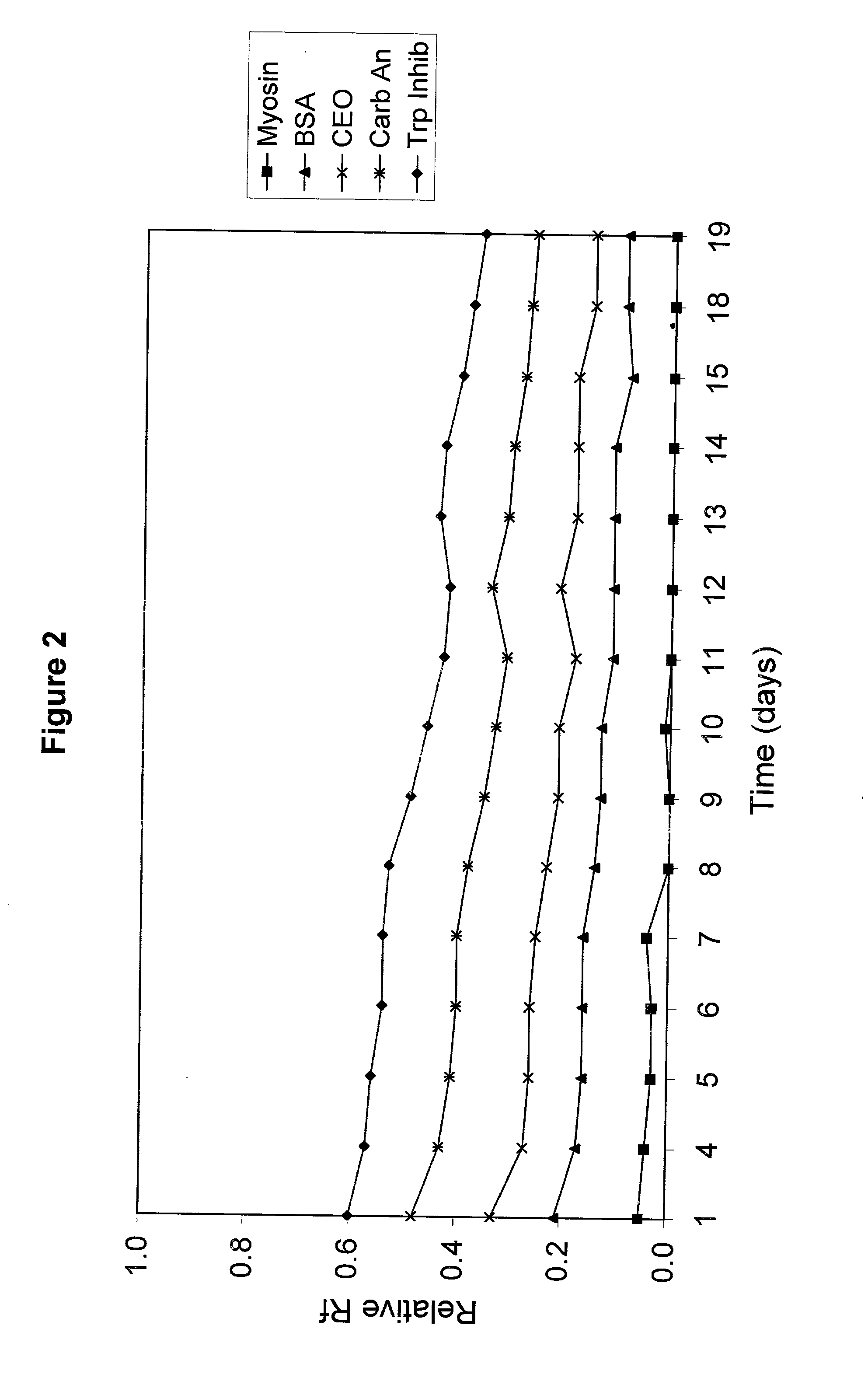Electrophoresis gels
- Summary
- Abstract
- Description
- Claims
- Application Information
AI Technical Summary
Benefits of technology
Problems solved by technology
Method used
Image
Examples
example 1
[0061] A polyacrylamide gel was cast with an acrylamide concentration of 5%T / 4%C in the stacking region and 10%T / 3%C in the resolving region of the gel. The concentration of Tris in the gel was 0.2M and the pH of the gel was adjusted to 7.0 using HCl. Two different samples were separated on this gel using an electrode buffer of Tris (25 mM), Glycine (191 mM) and SDS (0.1%). The protein samples were snow pea protein and wide range molecular weight marker which was a commercially available marker containing samples denatured by the addition of DTT. The marker was reconstituted in water as per the manufacturer's instructions. The gel was electrophoresed for 90 minutes at a voltage of 200V. Trypsinogen, trypsin inhibitor and aprotinin in the wide range marker stayed with the tracking dye and moved off the end of the gel.
[0062] The proteins in the standard that remained on the gel were Myosin (Rabbit Muscle, 205 kDa), .beta.-Galactosidase (E. coli, 116 kDa), Phosphorylase b (Rabbit Muscl...
example 2
[0064] A polyacrylamide gel was cast with an acrylamide concentration of 5%T / 4%C in the stacking region and 10%T / 3%C in the resolving region of the gel. The concentration of Tris in the gel was 0.2 M and the pH of the gel was adjusted to 7.0 using HCl. A sample of snow pea protein and wide range molecular weight marker were separated on this gel using an electrode buffer of Tris (100 mM) and HEPES (100 mM) and electrophoresed for 30 minutes at a voltage of 200V. Trypsin inhibitor, lactalbumin and aprotinin stayed with the tracking dye and moved off the end of the gel.
[0065] The proteins in the standard that remained on the gel were Myosin (Rabbit Muscle, 205 kDa), .beta.-Galactosidase (E. coli, 116 kDa), Phosphorylase b (Rabbit Muscle, 97 kDa), Fructose-6-phosphate Kinase (Rabbit muscle, 84 kDa), Albumin (Bovine Serum, 66 kDa), Glutamic Dehydrogenase (Bovine Liver, 55 kDa), Ovalbumin (Chicken Egg, 45 kDa), Glyceraldehyde-3-phosphate Dehydrogenase (Rabbit muscle, 36 kDa), Carbonic An...
example 3
[0067] A polyacrylamide gel was cast with an acrylamide concentration of 5%T / 4%C in the stacking region and a gradient from 5%T / 2.5%C to 20%T / 5%C in the resolving region of the gel. The gel was at pH 7.0 with a Tris concentration of 0.2 M where the pH was adjusted using HCl. Samples of snow pea protein and commercially available wide range molecular weight marker were separated on the gel. The gel was electrophoresed for 30 minutes at a voltage of 200V in an electrode buffer comprised of Tris (100 mM) and HEPES (100 mM). Protein bands from Myosin (205 kDa) to Aprotinin (6.5 kDa) were resolved on the gel.
[0068] The proteins in the standard that remained on the gel were Myosin (Rabbit Muscle, 205 kDa), .beta.-Galactosidase (E. coli, 116 kDa), Phosphorylase b (Rabbit Muscle, 97 kDa), Fructose-6-phosphate Kinase (Rabbit muscle, 84 kDa), Albumin (Bovine Serum, 66 kDa), Glutamic Dehydrogenase (Bovine Liver, 55 kDa), Ovalbumin (Chicken Egg, 45 kDa), Glyceraldehyde-3-phosphate Dehydrogenase...
PUM
| Property | Measurement | Unit |
|---|---|---|
| Temperature | aaaaa | aaaaa |
| Time | aaaaa | aaaaa |
| Time | aaaaa | aaaaa |
Abstract
Description
Claims
Application Information
 Login to View More
Login to View More - R&D
- Intellectual Property
- Life Sciences
- Materials
- Tech Scout
- Unparalleled Data Quality
- Higher Quality Content
- 60% Fewer Hallucinations
Browse by: Latest US Patents, China's latest patents, Technical Efficacy Thesaurus, Application Domain, Technology Topic, Popular Technical Reports.
© 2025 PatSnap. All rights reserved.Legal|Privacy policy|Modern Slavery Act Transparency Statement|Sitemap|About US| Contact US: help@patsnap.com



